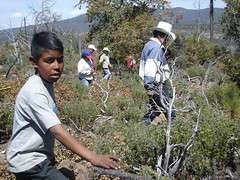
I went tree planting with the residents of a remote Indigenous village in the rugged sierra of Chihuahua state last month. The area was charred by forest fires a few years back and normally in Mexico, reforestation efforts aren't very successful. Here's my account from today's Miami Herald Mexico Edition:
By David Agren, near Bocoyna, Chi
Josefina Torres Lagarda recalls the night several years ago when a wildfire swept towards her tiny farm in the remote sierra of Chihuahua state. The blaze mercifully spared her home and land, where she and her husband grow corn, beans and oats and raise animals, but the aftereffects have been harsh. The blackened nearby hills still are still barren – even with reforestation efforts two years ago. Due to soil erosion, swift streams that form during the rainy season now wash out much of her crop.
"We've barely harvested anything over that past few years,” she explained.
Torres' problems with erosion and deforestation are hardly unique in Chihuahua, the republic's biggest state. Although arid in parts, pine and oak forests cover much of the state's rugged sierra, site of the Copper Canyon and home territory for the indigenous Tarahumara. Unfortunately, poor forest practices are rife and environmental concerns are often an afterthought in much of the region as timber barons wield enormous influence and clandestine loggers take to the forests in large numbers. Murky interpretations of agrarian laws, ejido conflicts and the exploitation of indigenous peoples living in the woods further complicates things. Government-sponsored land management plans are often ignored.
The results, according to Chihuahua-based experts working in the area, have been troublesome for the local indigenous populations and the environment.
Most of the old pine forests in Chihuahua have already been cut down,” Manuel Sosa, professor of natural resource sciences at the Autonomous University of Chihuahua, adding that the soil in many parts of the state is now extremely thin.
To change things – at least on a small scale – Sosa and a Chihuahua-based NGO, Fuerza Ambiental, A.C., started working on a reforestation program in the 80-hectare burned-out area near Tuchiachi, an indigenous village only accessible via a beat-up single-lane road running from the Chihuahua-Creel highway up into the woods. Earlier this month, under Sosa's guidance, some 20 residents of Tuchiachi and the town governor fanned out across three 1,000-square-meter grids and walked shoulder-to-shoulder downhill, counting the up-and-coming trees sprouting from the thin soil. Later, many of the young trees were measured.
While lunching on sandwiches afterward, Sosa told the community members that the zone they had just inspected contained an average of 510 trees per hectare. He called the results encouraging, but added the forest still needed a more time to recover.
Gina Uribe Zuñiga, an anthropologist and founder of Fuerza Ambiental, explained that local reforestation efforts are often poorly executed. Many residents in the affected areas usually lack knowledge and expertise in overseeing a recovery. In the case of Tuchiachi, many of the trees were planted too close together. Many of the seedlings also arrived dead. She said Conafor, the national forest commission, “Threw money at (the problem),” and didn't do much else in Tuchiachi.
To increase the odds of success in Tuchiachi, Fuerza Ambiental is training some of the promising locals in advanced management techniques. While participating in the tree counting, Uribe commented, “I want to show (Conafor) another way ... what's really going on in the region.”
Uribe and her partner in Fuerza Ambiental, Cliff Mathies, started working with the residents of Tuchiachi about two years ago. Fuerza Ambiental focuses its efforts on helping with reforestation and restoring creek beds, inventorying natural resources and helping indigenous communities assert their rights. Uribe and Mathies initially proceeded slowly in Tuchiachi as many residents were somewhat wary of outsiders offering help. After more than a year of establishing relationships, the locals started attending consultation sessions, which Mathies, said were important for succeeding and establishing trust.
“We've done a year and a half of diagnosing, speaking with (the locals) and having them tell us what they need,” said Mathies, who initially came to Chihuahua in the mid 1990s as part of a model-forest program sponsored by the Canadian government. (He said powerful forestry interests and waning government enthusiasm in Mexico scuttled the program.)
Many of the concerns centered on the forest, which Mathies described as “the lifeblood of the sierra,” along with water and soil erosion.
"The impact of soil erosion in the sierra is often noticed far beyond the sierra in Chihuahua's major cities and even the neighboring states. Fuerza Ambiental originally started working in the sierra with the goal of improving the local watershed, which supplies Chihuahua city and Ciudad Juárez with water and feeds both the Rio Grande and rivers flowing west towards the rich agricultural areas of Sinaloa and Sonora on the other side of the continental divide. (Improving water flow to the Rio Grande via the Conchos River in Chihuahua was seen as a way of helping Mexico repay a previous water debt.)
"Almost everyone in the state depends on the sierra (for water),” Manuel Sosa explained.
Closer to Tuchiachi, Josefina Torres Lagarda expressed hopes the reforestation efforts would abate the water rushing through her land and help restore the local area.
"We hope that the mountain is cared for ... that we save the heart of the forest.”


No comments:
Post a Comment